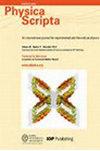利用量子处理器分析强相关材料
IF 2.6
3区 物理与天体物理
Q2 PHYSICS, MULTIDISCIPLINARY
引用次数: 0
摘要
本研究通过将传统的量子簇方法调整为量子电路模型,介绍了一种分析强相关系统的系统方法。我们开发了一种更简洁的簇格林函数计算公式,只需要对量子电路进行实数计算,而不是复数计算。这种方法本质上更适合主要产生统计概率的量子电路。作为一个示例,我们探索了二维晶格上的哈伯德模型。基态是利用量子通科技有限公司(QuantumCTek Co., Ltd.)提供的配备 66 个量子比特的超导量子处理器 "小红 "确定的。随后,我们利用具有可控噪声的电路模型计算了簇的实时迟滞格林函数,并以此确定了晶格格林函数。我们对晶格系统绝缘体阶段的带状结构进行了研究。这项初步研究为在凝聚态物理学领域探索大量创新物理学奠定了基础。本文章由计算机程序翻译,如有差异,请以英文原文为准。
Utilizing quantum processor for the analysis of strongly correlated materials
This study introduces a systematic approach for analyzing strongly correlated systems by adapting the conventional quantum cluster method to a quantum circuit model. We have developed a more concise formula for calculating the cluster’s Green’s function, requiring only real-number computations on the quantum circuit instead of complex ones. This approach is inherently more suited to quantum circuits, which primarily yield statistical probabilities. As an illustrative example, we explored the Hubbard model on a 2D lattice. The ground state was determined utilizing Xiaohong, a superconducting quantum processor equipped with 66 qubits, supplied by QuantumCTek Co., Ltd. Subsequently, we employed the circuit model with controllable noise to compute the real-time retarded Green’s function for the cluster, which is then used to determine the lattice Green’s function. We conducted an examination of the band structure in the insulator phase of the lattice system. This preliminary investigation lays the groundwork for exploring a wealth of innovative physics within the field of condensed matter physics.
求助全文
通过发布文献求助,成功后即可免费获取论文全文。
去求助
来源期刊

Physica Scripta
物理-物理:综合
CiteScore
3.70
自引率
3.40%
发文量
782
审稿时长
4.5 months
期刊介绍:
Physica Scripta is an international journal for original research in any branch of experimental and theoretical physics. Articles will be considered in any of the following topics, and interdisciplinary topics involving physics are also welcomed:
-Atomic, molecular and optical physics-
Plasma physics-
Condensed matter physics-
Mathematical physics-
Astrophysics-
High energy physics-
Nuclear physics-
Nonlinear physics.
The journal aims to increase the visibility and accessibility of research to the wider physical sciences community. Articles on topics of broad interest are encouraged and submissions in more specialist fields should endeavour to include reference to the wider context of their research in the introduction.
 求助内容:
求助内容: 应助结果提醒方式:
应助结果提醒方式:


